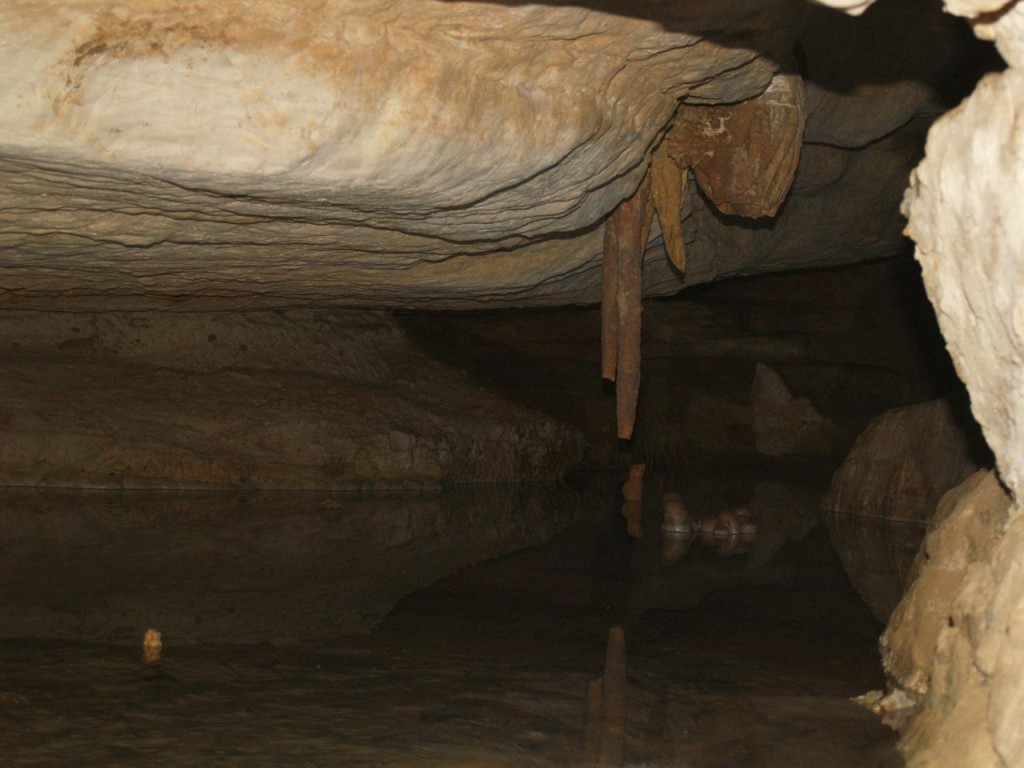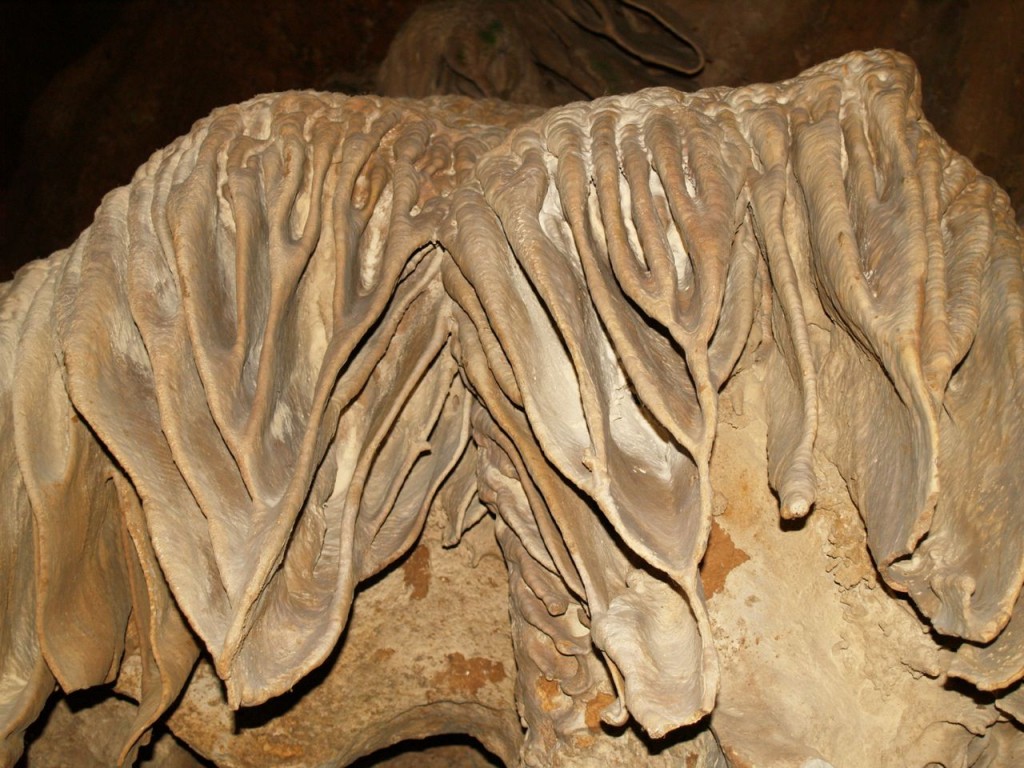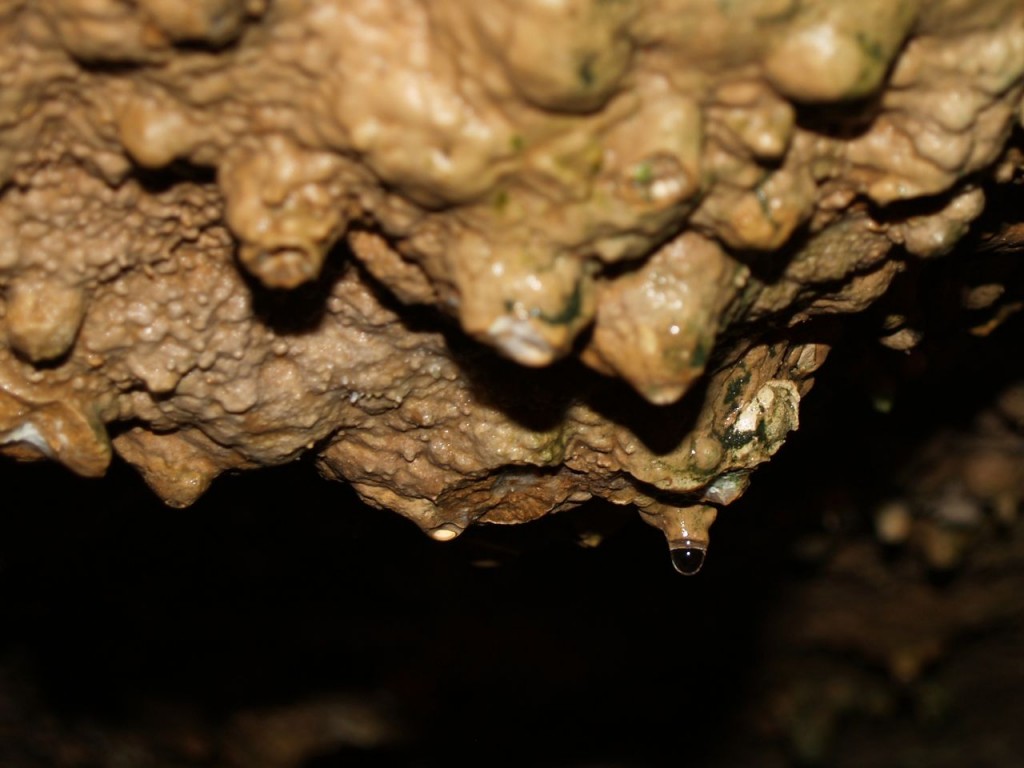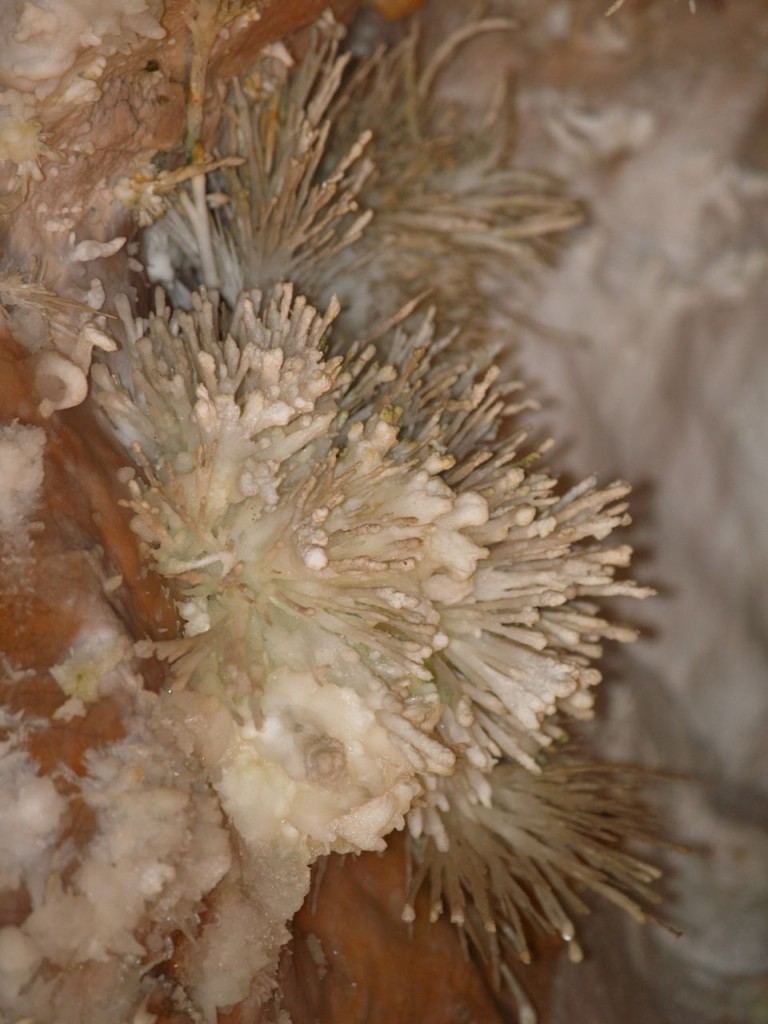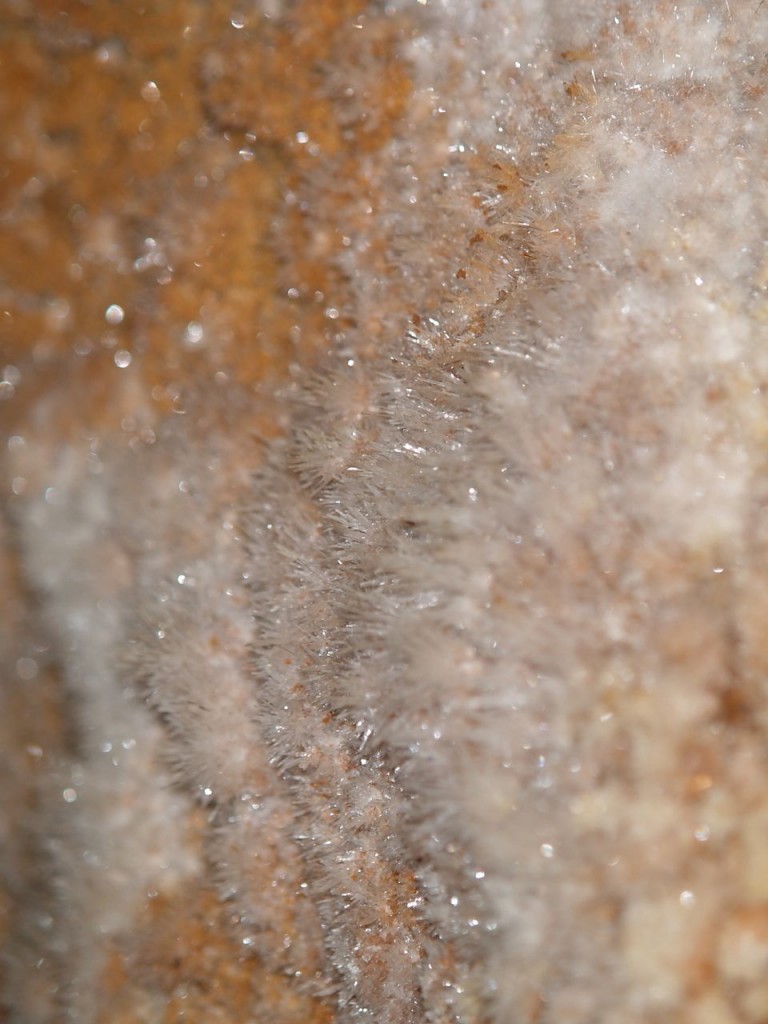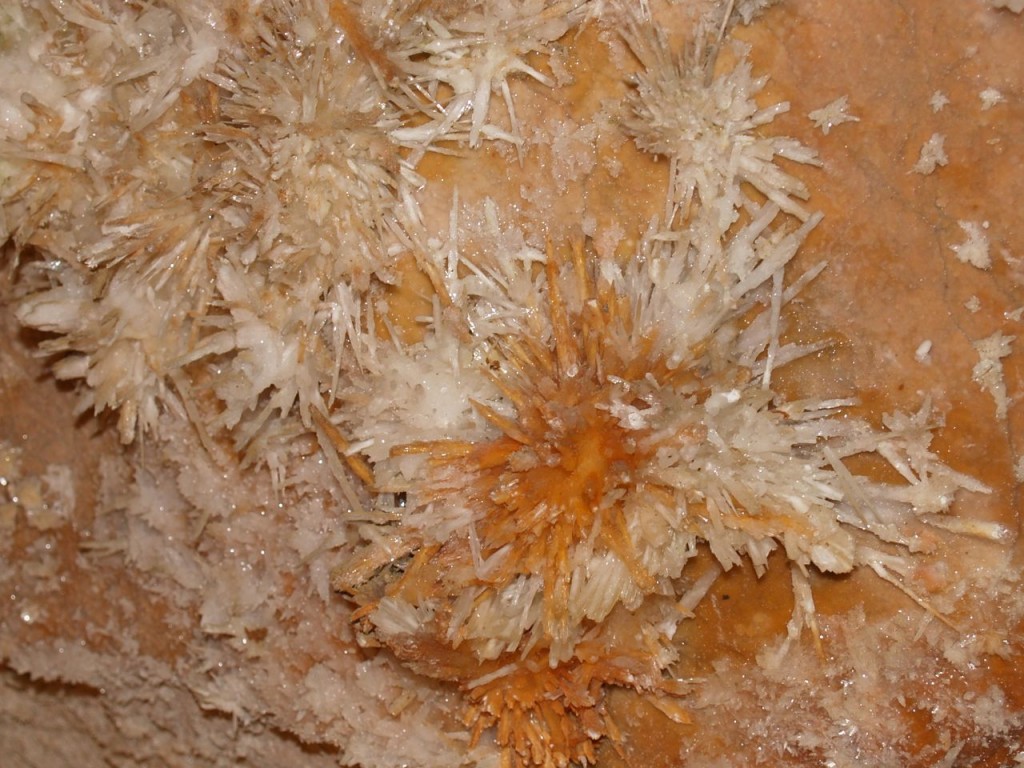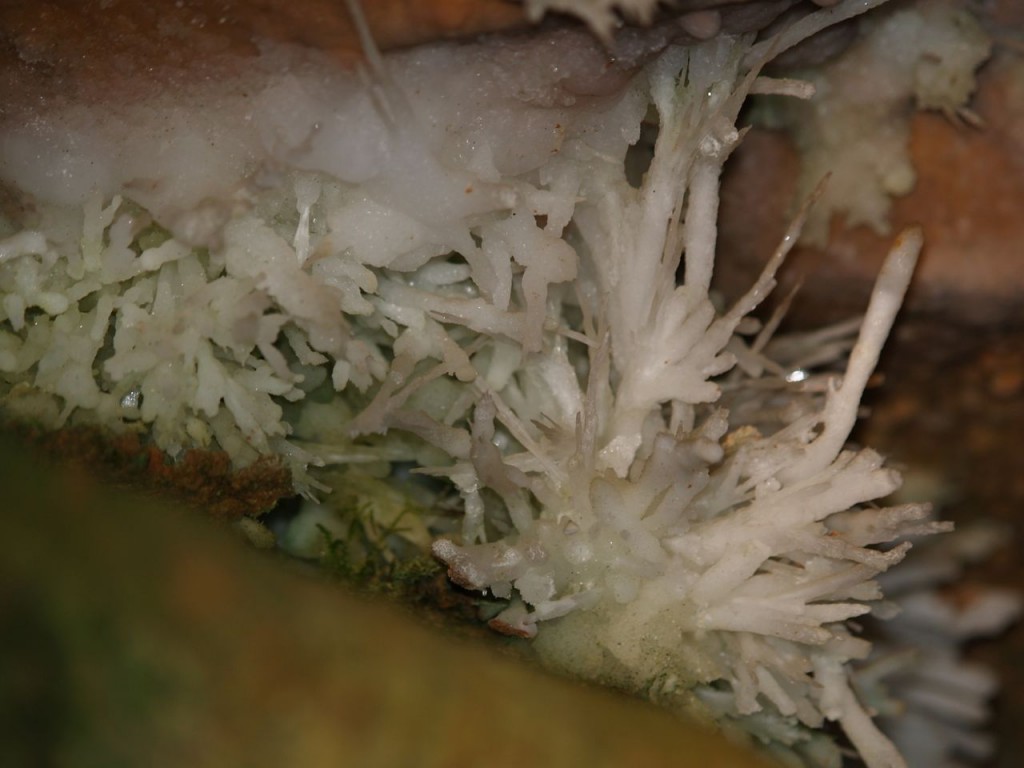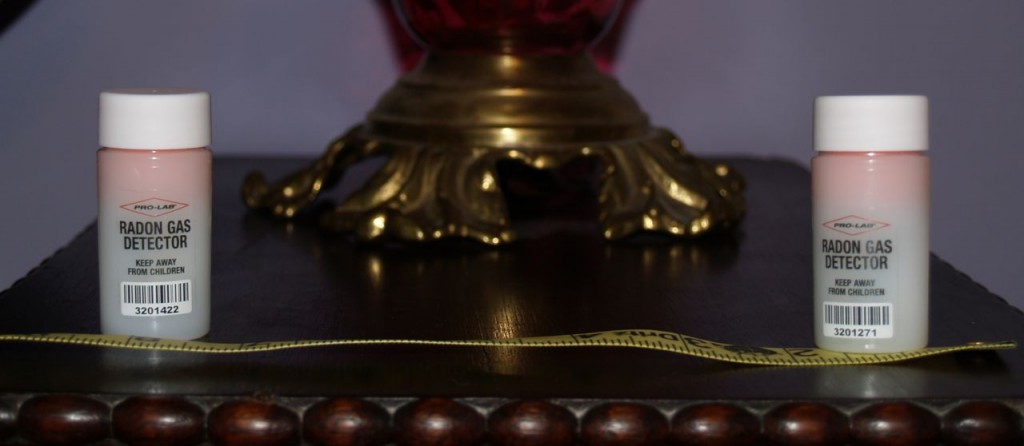I visited Skyline Caverns today in Front Royal, Virginia. I have decided that caverns and other attractions that have some science involved need to have two different tours: one for people interested in the science, such as the geology of cave formation, and others who just want to see the pretty stuff and be told that a particular formation looks like Snoopy. Skyline Caverns has some nice formations and some neat underground rivers and lakes, The lakes are really neat to see because the water is completely still and forms a mirror reflecting all the formations above it. The best part of the tour of Skyline Caverns was the anthodites, which are absolutely beautiful six-sided calcite crystals. According to the tour guide, their existence was first discovered in Skyline Caverns by Walter Amos, the geologist who discovered the caverns.
Tag Archives: Science
Science Education with a Corpse Flower
During my two weeks of daily visits to the US Botanical Garden (USBG) to see the corpse flower, I talked to many people about the corpse flower at the USBG, on Twitter, on Facebook, and face to face in many other places. My website got record traffic. The news media ran stories about the corpse flower. On July 22, the day it was in peak bloom, there was a mass of people waiting, including me, to get into USBG before it opened at 10 am. My post for that day is titled Corpse Flower: July 22 am because I intended to get a second set of photos that afternoon. However, when I went back that afternoon at 5 pm, there was a line three blocks long of people waiting to get in to see it. I decided I didn’t have time to wait in that line. People were clearly interested in this plant. It was a big thing. I and thousands of other people were watching this plant every day on a live cam. To be clear, while this plant did grow amazingly fast, it was not so fast that you could see it growing if you just stared at it. We were watching a plant sit there, and many of us were obsessed.
Even better than this obsession watching it, was people’s interest in knowing more about it. Everyone wanted to know when it would bloom and why does it smell. Many people also wanted to know where it was from, was it really the largest flower in the world, where is its leaves, and how does it reproduce. Many of the people I talked to were perfect strangers who did not have a science background or would normally be interested in science type topics, but they found this plant interesting. It was a perfect opportunity to educate people about science, nature, and conservation. While I was happy to see how some employees and volunteers at USBG responded to all the interest, I have to admit I was really disappointed at some very squandered opportunities of which USBG on the whole did not take advantage.
Part of my disappointment with USBG is that I am comparing it to what happened when a corpse flower named Lois bloomed at Houston Museum of Natural Science (HMNS) in 2010. HMNS set up a live cam also and also set up a Twitter feed to run on the same webpage as the live cam where any tweets with a designated hashtag would show up, so people could discuss the corpse flower. Like many corpse flowers, Lois was unpredictable and seemed to be taking too long to bloom. So while everyone was waiting for Lois to finally bloom, someone not associated with HMNS, set up a parody Twitter account called @CorpzFlowrLois, and the first tweet was “Maybe I’ll bloom, maybe I won’t.” This pretty much summed up the plant. The tweets from @CorpzFlowrLois kept getting funnier and funnier as Lois was given a diva personality complete with a personal assistant who was constantly late bringing her her cappuccino, an ex-boyfriend back in Sumatra who wanted her back, and the real life HMNS horticulturist whom she thought touched her too often. HMNS had no idea who was behind @CorpzFlowrLois, but they just went with it and linked to the account on their website with a disclaimer because as @CorpzFlowrLois got more and more followers, HMNS got more and more admission-paying visitors to the museum as well as website visitors. HMNS hosted webinars and educated everyone about the corpse flower and the related science.
Thus, it is probably slightly unfair for me to compare USBG to HMNS because partially thanks to @CorpzFlowrLois, Houston and the internet went absolutely nuts over Lois. I saw two different parody Twitter accounts set up for USBG’s corpse flower, but neither of them were as prolific or as funny as @CorpzFlowrLois. Also, for whatever reason, USBG did not embrace social media at all. Even though they knew they were going to get more visitors and interest because of the corpse flower, they didn’t seem to know what to do with it. The fact that they don’t charge admission may have something to do with their response. However, they also didn’t do what I think would be incredibly easy things to help educate people and satisfy their curiosity. They had two small posters set on either side of the corpse flower with some information about and photos of corpse flowers. They passed out pamphlets with some information and also had some information and photos on their website. However the information was somewhat basic and did not answer many of the questions I constantly heard people ask them. They also did not have many photos, and to be blunt, I think my photos were much better. When I talked to people at USBG, I always referred them to my website to see more photos, especially if they wanted to be able to see the progression of it growing as you couldn’t do that on USBG’s website.
People, including myself, were asking them everyday if the corpse flower was still growing or how tall it was. The staff measured the height and width of the corpse flower daily if not more often, so generally the staff member who was near the corpse flower would know the latest information and could answer those questions. While I suppose I should have suggested it, I don’t know why they didn’t just set up a white board or post on the website the growth information so people wouldn’t have to find a staff member to ask. People wanted to know more about the reason for the smell and how the plant reproduced, but the information that USBG had was minimal.
However, my greatest annoyance with USBG was with a few of the staff members. To be clear, most of the ones to which I either talked or listened, were knowledgable and great, if somewhat exhausted from the nonstop questions. However I heard two different staff members not only not take advantage to educate but also just plain use wrong terminology. On one of my daily corpse flower visits, I heard a man tell some people it was the largest flower in the world. I turned around, smiled, and said it is actually the largest unbranched inflorescence. He said well yes, of course, that is actually a spathe, but he finds it best to avoid technical terms around non-technical people. I later realized he was actually a staff member, but he didn’t have his ID badge displayed prominently. He said he was plant educator and if you use technical terms, which evidently includes spathe and spadix, then people get disinterested and confused. I said I found the opposite to be true, if the subject is explained well, then people can not only understand technical terms but want to know more. For example, if you explain that what they are looking at is not actually a flower, then people want to know where the flowers are and why. Further, if you give a person the wrong information like calling the copse flower the largest flower in the world, then how exactly did you educate them?
This is not just my opinion though of people wanting to know the technical terms and full explanation, it is my experience. As I stated, I talked to complete strangers while at USBG. Many times our conversation would start off because someone would state to their friend or just out loud to whomever “I wonder when it is going to bloom” or “why does it smell.” When I could do so without seeming to be a know-it-all or intruding in their conversation, I would engage them in conversation and educate them when I could. If the question was about when it was going to bloom, I would often show them some of my photos on my iPhone and describe the changes. I would always state I am no expert, but here is how it has changed. I would also state what I heard from staff and what I could observe, such as there was one last sheath (green petal like structure) that needed to fall or the staff member said it grew another six inches yesterday, and it needs to stop growing before it will bloom. I had wonderful, sometimes long conversations with people, and I always used proper botanical words when I knew them, showing the people how the structure we were waiting to open was actually a spathe that was protecting the real flowers inside it. Never once did a person get disinterested or tell me they didn’t understand me. They just asked me more and more questions that I tried to answer if I could. Many times while talking with one or two people, I would essentially draw an audience, and 15 minutes later I was surrounded by people all wanting to know more about the plant. I would always be forced to give everyone a disclaimer that I am not a botanist, I am just obsessed with the corpse flower and spend too much time on the internet.
When talking about the copse flower, if you just call it a flower, then you can’t really explain why it smells or other topics people were so interested in knowing. Sometimes when talking to people I would use the word blossom initially instead of spathe. I did that so that I did not incorrectly call it a flower, but once I talked more about it, I could explain how it was really an inflorescence. When talking about the corpse flower to people, I think back to high school chemistry where students are originally taught the Bohr model of the atom. The teachers explain, this model is not correct. but it was a good way to initially describe the atom, and later students will be confused with the quantum model of the atom because no one really understands the quantum model of the atom. As the statistician George E.P. Box stated “essentially, all models are wrong, but some are useful.” Thus calling the corpse flower a flower is a wrong model, and it can be useful, if and only if, the true structure of it is later described.
I did not write this blog post to bash USBG. I really appreciate how they set up the live cam, had extended hours (although I wish they had extended their hours on the night it actually bloomed), and made their staff available to educate people who came to see this magnificent plant. I just wish they had taken more advantage of the amazing opportunity to educate people who would normally not come to a botanical garden about nature and science. It can be difficult to interest people in nature and science, and when something comes along that grabs people’s interest, you have to take advantage to educate. I took advantage of it to talk to and educate friends and complete strangers about the science of this fascinating plant and how amazing nature is, and it was a wonderful experience that I will never forget.
Mu is Not U
Time for another blog post where I try to improve science grammar.
This is the lower case Greek letter mu: μ. This is the lower case Latin letter u: u. Latin letters are, of course, what are used in the English alphabet as well as many, many other languages. While μ and u look similar, they are different. The Greek letter mu, uppercase Μ, is closer to the Latin letter M. The Latin letter U (uppercase, or u, lowercase) is more related to the Greek letter Upsilon (uppercase Υ, lowercase υ).
So now that I got that out of the way, when it comes to science in particular, μ and u are NOT interchangeable. In the International System of Units (SI), otherwise known as the Metric system, μ is the symbol used to represent the prefix micro-. “μ” can easily be added into a document using a insert symbol compound. It is an easy procedure, and there is no need to be lazy and just use “u”. “u” does not mean micro-. It is wrong. Don’t do it.
Speaking to High School Students
I was asked to speak at The Washington Youth Summit on the Environment (WYSE) to a small group of the delegates about my career as environmental engineer/health scientist. The delegates are high school students. I’ve never done anything like this before, and I can’t remember the last time I’ve spoken to a group of high school students about anything. I was told to talk about my career and talk about specific projects on which I’ve worked. I prepared a few slides on the basics of risk assessment as that is the general field in which I work now and then quite a few slides on my dissertation and a few slides on the project I am currently working at work. I wasn’t sure what to expect. Would they be interested in this at all? Would my slides be interesting or too far over their heads? I took out what I thought were the more advanced and complicated slides and just focused on graphs and photos. I wanted to focus on the big picture.
Part of my problem with giving this presentation was, the more educated you become, the more you take for granted what other people know. At least, I have that problem. I have had so much math education including three semesters of calculus, differential equations, linear algebra, probability, statistics, and biostatistics, that I’m flabbergasted when I meet people who can’t do or understand basic algebra or understand what a square root is. Certainly, you can make an argument that this is a sign of the failure of the US education system, but people’s education level is what it is. If you want to explain something to someone, than you have to be able to explain it to them on their level. These are high school students, and I can’t expect them to know information that is not taught until college or after. Thus, I have a group of high school students that I need to talk to about the work that I do and the work I did to earn my Ph.D. I am not entirely sure how to do this. I don’t quite frankly remember what I knew in high school. I have no idea what these students know. I don’t want to bore and confuse them by talking at so high a level that they can’t understand me, but I don’t want to insult them by explaining things they already know.
I am really not sure how I did. The one thing I am fairly sure about is that I babbled and rambled a few times. I am really not the best speaker. I am not a bad speaker, but I do much better if I have a set text that I am reading or very specific things with high points written on slides. I didn’t do that for this talk because I wanted to be able to change what I was saying once I got there and started getting questions. They did ask me questions. They asked me great questions in fact. However those questions made me realize just how much I know and forget that other people don’t know. That is in no way meant to be an insult to these students. I was really impressed with them. Like I said, they asked great questions. Also, they were very polite and politely listened even when I am sure I started to ramble. I really appreciated their attentiveness, and I loved their questions.
For example, one of the first questions I got was on one of my first slides, which had the word epidemiology on it. I was asked “what is epidemiology?” This is probably where it hit me that I had no idea what they knew. It didn’t really dawn on me that some (or all) would not know what that word meant and what that science field is. Again, that is not an insult to them. If anything, I was annoyed with myself for not considering when I learned that word. I am glad I was asked the question. It gave me a chance to tell them about John Snow and the London cholera epidemic. I am fairly sure all epidemiology courses are legally required to start with a discussion on John Snow and the London cholera epidemic, so I had fun telling them about it.
I can’t remember all the questions I got, but I got quite a few. I loved this because that meant the person asking the question was listening and engaged. When I describing issues related to soil and groundwater contamination, I got a very simple question as to how these chemicals get into the soil and groundwater. I LOVED this question. I can’t describe all the reasons why I loved this question, but one is because I am an engineer, and I get frustrated when people think we build things and then no maintenance is ever needed. Bridges in the US keep falling down, and the American Society of Civil Engineers gives our infrastructure a D+ grade. One of the reasons is lack of maintenance. I got to explain to the students about maintenance and inspections and things simply not being designed or built to last forever. I also explained how decades ago, people used to just dump chemicals in the ground or water and never think of the consequences.
I also got some questions of how to find out more information on different topics and things I discussed. They wanted to know more. As I always want to know more, how could I not like these students? I hope some of them already have or are now on the internet reading more about the topics I only lightly discussed. Maybe one day I will meet them again professionally.
Giant Shiny Ball Play Thing
Last night, I went to Cultural Programs of the National Academy of Sciences (CPNAS)‘s D.C. Art Science Evening Rendezvous (DASER). It is a monthly discussion forum on art and science. They always have interesting speakers, and it is one of the cool things about living in the DC area. Anyway, last night upon walking into the room right before the program began, I was immediately intrigued by this enormous sphere siting in the corner of the room, which I dubbed the Giant Shiny Ball Play Thing.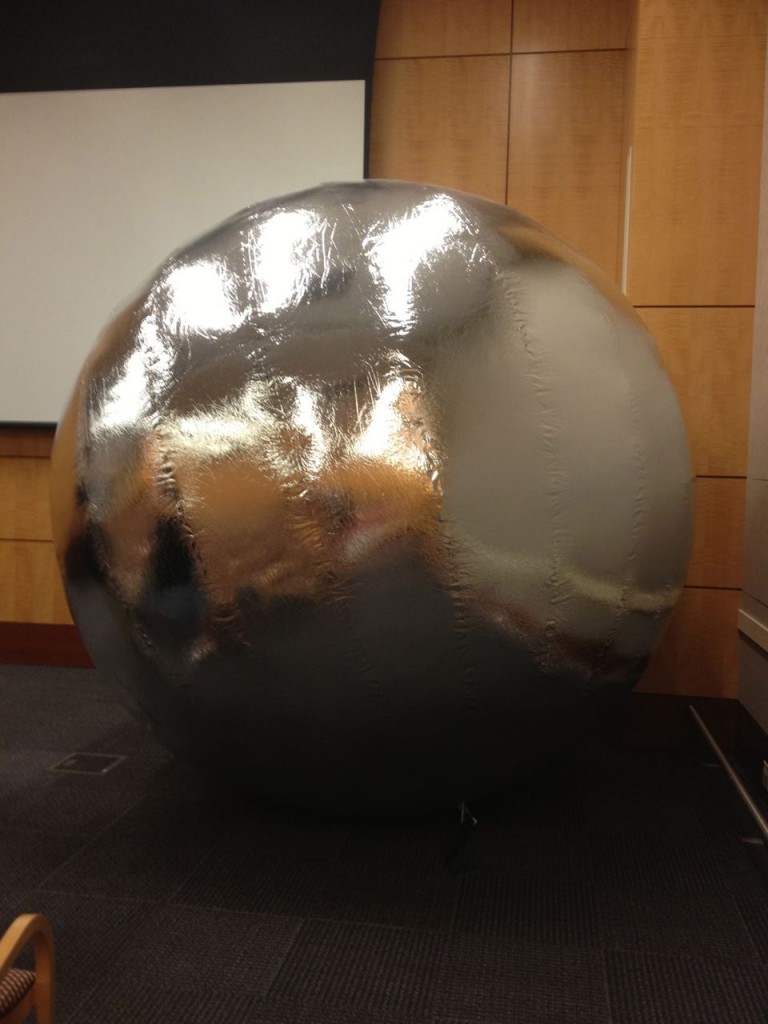
I had no idea what this thing was, and there was no mention of it in the program. I envisioned the amazing game of beach ball toss that a large crowd could play with it. The Giant Shiny Ball Play Thing was seriously one of the coolest things I had ever seen, and I wanted one. Sure it was probably about 10 feet in diameter and would never fit in my house. Even if it did fit in my house, putting a shiny inflatable ball in the same house with my cat and her claws would not end well at all.
I finally found out that the Giant Shiny Ball Play Thing is a reproduction of a satelloon. Greg Allen, one of the speakers, had it fabricated as part of his Exhibition Space exhibit. A satelloon is satellite balloon, of course, and I’m going to bet that either an engineer or scientist came up with that name. NASA made satelloons for Project Echo from 1956-1964. I am not going to describe the whole history because Greg Allen has a great summary of the project and the amazing satelloons. If you want even more history, you can read about it straight from NASA. The history is fascinating.
Thus the Giant Shiny Ball Play Thing is really a symbol of some incredible science and engineering history. I still want to play with it though. Also, I took a fun self portrait of myself in the satelloon.
 There, dear readers, now you know what I look like.
There, dear readers, now you know what I look like.
Finally, if like me, you can’t get enough of the Giant Shiny Ball Play Thing, Heather Goss created this fun Vine video of it being deflated.
Kilograms Do NOT Measure Weight
I think like many engineers, one of the reasons that I liked the idea of going into engineering was the mistaken belief that a career in engineering meant working with numbers and not having to write. I have never been very good with words. I love numbers. Numbers make sense to me. Words confuse me at times. Also, the English language in general makes no logical sense to me, and I am a native English speaker. [Well, I’m a Southern, so you can go ahead and make an argument against the native English speaker part.] I can’t spell worth crap because of the aforementioned English language illogical thing. This is actually fairly common among engineers. Had my family known the warnings signs, it would have been obvious since I was about 5 years old that I was destined to be an engineer. I have always been good with numbers, and I can’t spell worth crap. Take note parents, as these are the warning signs your child may be an engineer. Also, an early love of duct tape.
I am fairly good with grammar though probably because there are more rules and less exceptions. Partially because of this and for other reasons, at my current job, I often edit other people’s documents not just for science and engineering accuracy but also for grammar, readability, and clarity. I have also been a peer reviewer for a few manuscripts submitted to scientific journals, and previously, I used to edit manuscripts that were about to be submitted to peer review journals. I keep coming across certain words and phrases that are scientifically and grammatically incorrect. There are many grammar style manuals that exist, but I have yet to come across a science grammar style manual. If one exists, I would love for someone to point me to it. So I’ve decided to start writing about some of the most common and inappropriate phrases in the hope that maybe it will stop at least one one person from using these incorrect phrases.
The most common and completely wrong phrase I see is stating that something or someone weighs a certain number of kilograms. Ironically, non-US citizens, i.e. people who live in a country where they use the metric system, are just as guilty of this phrase as US citizens who sort of have the excuse that they live in a country that refuses to stop using the completely archaic and impossible to use if you are a scientist or engineer, English imperial or US customary units. For the benefit of everyone who doesn’t understand why this is wrong, let me explain why it is.
A kilogram is a unit of mass. Mass is the amount of stuff that an object has.
To say something weighs something, you are saying it has a certain amount of weight. A weight is a specific type of force, and because it is a force, weight, like all other forces, is measured in Newtons (N) in the metric system. Weight is the amount of force on an object due to gravity. Therefore, weight is the mass (the amount of stuff) multiplied by the acceleration due to gravity. If you happen to be a person on Earth with a mass of 70 kg, then since the gravitational acceleration on Earth is 9.81 m/s2, you have a weight of 687 Newtons (N). Let’s say you happen to be an astronaut, and the Moon program gets revived, and you go to the moon. Your mass will not change. Your mass will still be 70 kg, but once you arrive at the Moon, your weight will be about 114 N because the Moon’s gravitational acceleration is 1.63 m/s2. While you are on your journey to the Moon in space, there will be no gravity, so you will have no weight. You will be weightless, hence the fun videos of astronauts floating, but you will still have the same 70 kg mass.
To review, a person or an object has a mass that can be measured in kg. A person or an object that is on any celestial body with gravity has a weight that can be measured in N. It is completely incorrect to say that a person or an object has a weight in kg. It is also confusing. Does it mean you have a mass in that number of kg? Does it mean you have a weight in that number of N, not kg? Please, don’t use kg and say weight. Mass and weight are not interchangeable. They do not mean the same thing.
Short Term Radon Test Results
Previously I wrote that I was testing my house for radon. I got the test results back this week, and the test results came back as an average radon level of 2.9 pCi/L. The good news is this is less than the 4 pCi/L action level. The bad news is this is still elevated above average house level of 1.3 pCi/L. This test involved collecting radon over four days. At work, I am currently working on a project that involves looking at the indoor air variability due to radon or volatile organic compounds intrusion from the soil and groundwater. Thus, I know better than most how variable indoor air concentrations can be. They can vary a lot. Therefore, before deciding what to do, I have considered the following items:
- The test was done in winter under proper closed house conditions. Closed house conditions means keeping the doors and windows closed except for normal entering and exiting the house through the doors. This is not an issue in the winter because it is cold. This is also one of the reasons winter is one of the best time to perform the test, but it also means that the test will lead to higher results than if more open house conditions are maintained. When the weather is nice, I like to open the windows and doors, so that would generally mean at least during those times, the radon concentrations in my house should be much lower.
- The test was performed over four days. As I stated, indoor air concentrations can vary a lot, and in terms of those fluctuations, four days is relatively short term. Even ignoring the seasonal effect of closed versus open house conditions, the long term average radon conditions could be much higher or lower than 2.9 pCi/L. The reasons are not fully understood, but exterior temperatures and precipitation can affect it. A long term test over several months or even better a year, will give a much better understanding of the average concentration. If the results had been 1.3 pCi/L or less, than given the conditions, I would probably not be at all worried that the long term concentrations would be higher.
- The EPA recommends that the test be performed in lowest habitable portion of the house. As such, I placed the test in the guest room for that and other reasons stated previously. However, I am almost never in the guest room. I don’t have guests that often, and the door to that room remains shut most of the time. Thus the only air exchange in the room is via the ventilation ducts and a little underneath the door. Furthermore, my bedroom and all the common areas of the house (kitchen, living room, etc.) where I spend most of my time are upstairs and should have lower radon concentrations than the guest room. Therefore, even if the results from the guest room do accurately represent average radon concentrations, they are borderline for taking mitigation action and probably represent the highest levels in the house. While I don’t want to expose my guests to undue risks, especially since my guests are generally people I like or love, do I want to mitigate based on the results from this room?
- Finally, I’m a scientist, and I believe in validation and replication. This was one test result, and home test kits are generally not considered the gold-standard of any type of test. There is no doubt at least of some amount of inaccuracy with it.
Therefore, I have decided to test the house again, but this time for a longer duration. I have also decided to run two tests simultaneously. I plan to place two testers in the house, one in the guest room again and one upstairs in my master bedroom. I have ordered a long term home test kit that can be used to test between 90 and 365 days. I plan to run the test over an entire year to get a much better indication of what the long term average radon concentrations are in the house. Also, by testing both the guest room and master bedroom, I can better understand what my average exposure is both in terms of the average annual concentration and in the rooms where I spend the vast majority of my time. I will also add that while the guest room is a guest room now, as it is bedroom, legally and real estate-wise speaking, and thus in the future it could be a normal bedroom if my life changes or if I sell the house. Therefore I still consider it important to know what the long term radon concentrations are.
Check back in a year, and I will let you know what happened and how I am proceeding.
Testing My House for Radon
I’m testing my house for radon, and you should also. Winter is the best time to test your house for radon, which is one of the reasons I am testing it now. What is radon, and why am I testing for it? Keep reading.
What is radon? It is an odorless, tasteless, invisible gas that also happens to be radioactive. It is produced naturally from the decay of uranium, which occurs naturally in soil across the United States, and other countries and continents. The United States Geological Survey (USGS) has this neat map showing uranium soil concentrations across the US. Due to its radioactivity, radon is a carcinogen. In fact, it is the second leading cause of lung cancer after smoking. Radon gas is pretty much everywhere, both outdoors and indoors. Like all carcinogens, there is no safe level of exposure. You can’t completely avoid exposure because it is naturally occurring, but it is best to avoid it if you know it is present.
The US EPA estimates that the average home has an indoor radon concentration of 1.3 pCi/L, this means pico Curies, a unit of radioactivity, per liter of air. If your indoor air is above 4 pCi/L, then they recommend you fix your home. I’ll get to what fixing your home means next. Finally if the indoor air concentration is between 2-4 pCi/L, then they recommend you consider fixing the house. It is in that range that the concentration starts to get high enough above background that you might want to take action.
What happens if the radon concentrations in your house are high? First, don’t panic, your house can be mitigated to reduce the radon concentrations. You can hire a professional to install a mitigation system in your house. A mitigation system can either prevent radon gas from entering the house, or it can remove it from the house once it gets in. For example, one type of system sucks or pulls gas from beneath the house and then pipes it safely above the house where it can disperse into the atmosphere. Mitigation systems can be very effective and will greatly reduce your risk of lung cancer due to radon exposure.
Is your house at risk? As shown in the USGS map, some areas have higher concentrations of uranium in the soil than others. Areas with higher soil uranium concentrations will generally lead to higher radon gas concentrations. Also, houses with a crawl space will generally have less radon infiltrating the house than houses built on a slab or with a basement. The crawl space can allow the radon to dissipate before rising into the house. Houses with cracks in their slab are more susceptible because the cracks serve as a pathway for the radon to rise into the house. Also, pipes and conduits such as for wires from the house to ground can also allow radon to enter if they are not properly sealed.
So how do you find out if elevated levels of radon exist in your house? It’s fairly easy. Many states regulate the testing of radon, so you may try contacting your state radon department if it has one. Most of the time, you can go to your local home improvement store and buy a test kit for about $20. That’s what I did. The test kit I bought included two little containers that detect radon. The test kit had certain specific directions for the test containers such as they needed to be at least three feet off the floor, at least three feet from an exterior wall, etc., and they needed to be open for four days. The test containers were supposed to be placed six inches from each other. I presume you get two that are supposed to be placed in the same location for replicability. So here are the high tech test kits.
Yes that is a tape measure in the photo because it said to place them six inches apart, and I’m an engineer. Now be quiet. The detectors should be placed in one of the lowest habitable rooms of the house. My house is built into a hill such that the front door on the first floor is ground level, and the back door of the second floor is also ground level. I chose to place the detectors in the guest room, which is on the first floor and in the back exterior corner of the house. The back wall and 3/4 of the side wall of the guest room are underground exterior walls, and thus this room would be one of the most susceptible to radon infiltration from the ground. The room that serves as my office and workout room is next to the guest in the front exterior corner of the house. Two of its walls are also exterior, but only about 1/3 of its side wall is actually underground. However, there is a crack in the slab about two feet long in the office, so I considered whether the test kits should be placed in this room. [Due to the extensive renovation I’ve been doing on this house, I know where all the cracks and openings are.] That crack could serve as a major route for radon to enter the house. However, I ultimately decided that the guest room would be more susceptible to radon infiltration because of the amount it is underground.
After choosing in which room to place the detectors, I then found a good location that was far enough away from an exterior wall and above the floor. I then proceeded with the testing protocol. I unscrewed the containers and let them sit for four days. Whew, that was exhausting. I deserved a drink after initiating that test. Here is one of the detectors unscrewed. It’s quite simple looking.
After I let them sit for four days, I screwed the caps back on, filled out the form that came with them, and mailed them into the lab. It cost $30 to have them tested, so with the cost of the kit, the entire thing cost me $50. I consider $50 a small price to pay to make sure I am not unknowingly breathing in a carcinogen everyday. I’m currently waiting for the results from the lab, and I will update my blog when I get the results.
One final note, I said at the beginning of this post that winter is the best time to test for radon. The reason for this is winter tends to be the time that the radon concentrations in a house would be at the highest. When the weather is nice, people tend to open windows for ventilation instead of using the AC or heater, and people just tend to open doors more often to go outside for whatever reason. Thus in the winter, the house is more closed off, and radon concentrations can build up due to less exchange of the indoor air with the outdoor air. Where I used to live in south-eastern part of US, I probably had windows open more often in winter, as I constantly used the AC in the summer, so this might not hold true. That and the fact that indoor air concentrations can vary day to day, is why experts recommend that if you get high levels detected with a short term test, you consider doing a longer term test such as over several months, to determine what the longer term average is. The test kits do have false positives, especially at lower concentrations, so if you test your house, and it comes back high, once again, don’t panic. Test your house again, this time with a longer term test, and see what the longer term concentration is, and then determine if you need to take action. However, don’t remain ignorant about the risks. Test your house; it’s important and could save your life.
For more information:
Biomarkers: What are they and why do we study them?
In my previous post, I stated that as part of the research of which I was involved, we took blood and urine samples from our subjects, i.e. the guys we were studying. These men are exposed to chemicals during the normal course of their workday. [I say men because the all the people in our study were men. We would have happily used women in our study, but the industry we were studying is dominated by male workers, and we did not find any females to participate or who even worked at that type of job.] While the men were exposed to numerous chemicals, we were interested in one specific chemical that is known to cause detrimental health effects. While the subject was working with this chemical, we had a personal air sampling device clipped to his clothing in the shoulder area. This gave us estimate of the amount of chemical that was in his breathing air space. It was important for us to measure the breathing air space to determine exposure because the worker was spraying this chemical, so the chemical concentration would not be uniform in the air around him. As an example, if you are standing in your house, you can presume the air around you is evenly mixed. However, if while standing there, you spray air freshener or something like that, then as you spray and right after you spray, there will be a very high concentration of the air freshener in front of the direction you sprayed it. There will be a lower, but still high concentration right behind the sprayer, presumably this would be where you are, as the spray mixes. The high concentration will quickly spread out, and the freshener will mix in the rest of the room. If the house’s ventilation system is operating at the time, the freshener will mix faster than if the ventilation is currently off. Thus, the air sample that was taken in the breathing air space gave us an estimate of what the worker would have breathed in had he not been wearing a respirator. All the workers wore respirators though. Some wore half-face filter type respirators (similar to what you buy at a hardware store), which generally reduce the chemical concentration in the air breathed in by a factor about ten or so, if they are worn properly. Some workers wore supplied-air respirators, like a firefighter only these were attached to a hose with an outside air supply. This type of respirators generally reduces the chemical concentration in air breathed in by a factor of 1000. Therefore, we got an estimate of what the worker was exposed to in the air but not of the amount that made it into the lungs.
After the subject worked with the chemical, we applied and quickly removed tape strips (medical tape) to his arms, wrists, hands, and neck to determine the amount of the chemical that made it onto his skin in those areas. The medical tape removed the very top layer of epidermis and any chemical that was in that layer. Basically it was like we applied and then removed a band-aid without the gauze section. Thus, the tape strip gave us an estimate of how much chemical made it on to his skin, but it couldn’t tell us how much of the chemical actually made it through the layers of the skin and into the blood stream. Previous research had indicated that it was possible for this chemical to be absorbed through the skin. Despite what some people might think, skin is not impervious to chemicals. If it was, the nicotine patch and the estrogen patch wouldn’t work.
To summarize, we could estimate what the worker was exposed to via inhalation and dermal exposure, but we didn’t know what he actually absorbed or what made it into his body. That is where biomarkers can be useful. Biomarkers are measurements of a chemical or some other tell-tale sign of exposure in some biological sample. They can be measured in the blood, urine, fecal matter, exhaled breath, and many other bodily fluids or materials. Some materials are used more frequently because they are a lot easier to get. It is much easier to get someone to agree to urinate in a cup then to let you do a spinal tap for spinal fluid. Which bodily material is used also depends on what the chemical of interest is. If you are looking for a volatile chemical, the exhaled breath might be used. To get the exhaled breath, the person simply exhales into a specially designed glass tube. Similarly, a suspected drunk driver who has just been pulled over by the police, may be asked to breath into a breathalyzer. The concentration of the alcohol, or chemical, in that air can then be measured. This is a biomarker. If the chemical or its metabolite is excreted quickly, then it would be more useful to study the urine than the blood because there would probably be higher concentrations in the urine than the blood. However, the concentration in the urine is generally more representative of short term exposure, while the blood is more representative of long-term exposure.
The metabolism of the chemical is very important because it indicates what chemical you are actually looking for in the body and also where to look for it. For example, when a person is exposed to lead, it does not change into another chemical because lead is an element. Thus, blood lead level is a biomarker used to indicate exposure to lead. A person’s intoxication level can be measured by exhaled breath as stated. A suspected intoxicated person can also have a blood sample withdrawn, and the amount of alcohol in the blood can be measured. It is called the blood alcohol content, and it a biomarker of alcohol exposure. The body metabolizes alcohol and uses it for fuel, so looking for it in the urine is not all that useful, or least not for the police. Alcohol in the urine is more indicative of consumption hours beforehand (i.e. it doesn’t tell the police how drunk the person is at that moment, crucial for legal reasons), and it is not completely accurate because the rate and amount that a person metabolizes alcohol differs from another person. Like alcohol, many other chemicals that people are exposed to, are metabolized or partially metabolized by the body. Unlike alcohol, if it is a chemical that the body does not need and can’t use for nutrition, then the body will generally try to get rid of it as quickly as possible, if it can. The chemical we were studying in our research was like this. The body has no use for it, so it is partially metabolized and excreted. Thus we looked for the metabolite, not the chemical itself, in the urine or blood. To what degree a chemical or metabolite can be found in the urine versus the blood versus some other bodily fluid or tissue depends on the physical and chemical properties of the chemical or its metabolite. The metabolism, storage, and excretion pathway in the body of different chemicals is the subject of fascinating research and possibly another blog post.
Shipping Human Specimens
This morning I read an article in the Chicago Sun-Times concerning 17 human heads that had been discovered at Chicago O’Hare Airport. The best part of the headline is that it said “no foul play suspected.” This article has now been updated to state that “‘They were properly preserved and tagged as human specimens,’ said Tony Brucci, chief investigator for the medical examiner’s office” and that according to U.S. Department of Homeland Security, “the specimens appear to be legitimate medical samples.” The original version of the article, which I can no longer find, did not have all these details. It just said 17 human heads had been discovered, transported to the medical examiner’s office, and no foul play was suspected. This of course, sent most people’s imaginations wild as to how 17 human heads could end up at an airport without foul play. Perhaps this is a new way to save on air fair, just send a head, not the whole body.
The shipment of human heads, legitimately or otherwise, made me think of my human specimen shipping adventures while in graduate school. The field work that my fellow graduate students and I performed included three one-month trips to Seattle. Everyday we would drive to a different location to sample at the type of workplace we were studying. Among the samples we collected were blood and urine. For the vast majority of blood analysis, including the ones we were doing, the blood has to be separated into the red blood cell fraction and plasma section before it can be frozen. We were actually isolating the white blood cells also. To separate blood into these fractions, the blood has to be separated within 24 hours of being drawn, in truth, the sooner the better. Therefore, every night after sampling, we would ship the samples overnight to the east coast where our university was located. This may surprise some people, but this is actually not that big of a deal. Another grad student and I became certified hazardous materials shippers to do everything properly. In the case of our biological samples, the blood and urine, they could be shipped as “exempt human specimens.” This is specific term for shipping that meant our samples were not infectious and only required certain precautions to ship. Unless a person has a urinary tract infection, urine is sterile. Blood of course can carry many infectious agents, but if a person can be reasonably believed to be healthy and free of a blood-borne infection, then the blood can also be assumed to be non-infectious, and the blood can be shipped as an exempt human specimen.
Therefore every night after sampling, we would put the blood and urine samples with ice packs in a styrofoam container that was within a cardboard box. The cardboard box was clearly labeled “EXEMPT HUMAN SPECIMENS” as per shipping rules. We would then ship via FedEx, or if we couldn’t make it to the FedEx drop off before the overnight cut off for east of the Rockies (FedEx had an hour later drop off for west of the Rockies, presumably those went to a different sorting center), then we would drive to SeaTac airport and ship via cargo on a passenger aircraft. Shipping cargo on a passenger aircraft was an adventure. This was post 9/11, and they had started to implement more security measures for cargo. I don’t fully know what the security measures were then or today, but let’s just say, I don’t have a lot of faith in the security of cargo. In any event, the first time I dropped a box off at the passenger airline, which I won’t be naming, after going through a whole lot of paperwork, the employee took the package which had already been sealed. He asked if he could open it to examine the contents for security reasons. As he had no gloves on, I said, of course you can examine it, but to avoid contamination of my samples and for your own safety, please put on latex or nitrile gloves. He stopped and stared at me and asked why. Another employee who was working on the paperwork stopped what he was doing, looked at the first employee, and then the second employee and I at about the same time, said because the package contains human specimens, as it states on the outside, and as all the paperwork states. The first employee then said “oh” and looked a little embarrassed and took the package to the back, hopefully to be x-rayed or something. I say hopefully because as someone who flies, I am hopeful but not confident all cargo gets x-rayed. The fact that the employee was going to open a package without reading or noticing the large letters on the outside that said “EXEMPT HUMAN SPECIMENS” made me rather wonder how much they check things they accept and how much their employees might endanger themselves by not paying attention. Things were much easier when we could make it to FedEx, and they ship thousands (millions?) of these types of packages everyday. [This is not a plug or advertisement for them.]
The packages’ return trip was also made me wonder how much people question or don’t question things. After our fellow grad students back at the lab had received a week’s worth of packages or so, they would put the thawed ice packs back in the styrofoam, close everything up, and ship them back to us via FedEx ground, so we could reuse the boxes. The first time they shipped boxes back, they didn’t bother to remove the taped labels that said “EXEMPT HUMAN SPECIMENS”. I thought I had told them to do this, or perhaps I just assumed they would. I don’t know if there is anything legally or technically wrong with shipping boxes labeled as exempt human specimens that don’t actually contain human specimens or anything else for that matter. However, as we were shipping them back via ground to save money, and it took five days to get from our university to Seattle, I would think it would be better to remove the labels so that no one at FedEx questioned why or what kind of specimens would not go bad over the course of five days. Because the label said “exempt”, it should not change the shipment method, but packages shouldn’t be labeled as something more dangerous than they are. There are some types of dangerous goods that can’t be shipped via ground because it takes too long or it would affect the route (think of all those freeways and roads that say “no hazardous cargo”). Conversely there are some dangerous goods that can’t go in an airplane. However, I guess I worry too much because the packages arrived at our hotel without any problems or questions from FedEx. I guess FedEx was not concerned with five day ground shipment of exempt human specimens, whatever they might be.
I’m not entirely sure what the hotel employees thought of us, but they must have wondered. We were there for an entire month, and the people at reception certainly knew me if only because we were rather unusual guests. We had a small freezer in our room to store our non-biological samples before shipping them back to the lab. We had stacks of empty boxes labeled “EXEMPT HUMAN SPECIMENS” and other boxes labeled for the chemicals we shipped. My room had boxes of urine and blood sample collection supplies. Another room had a bunch of charging personal air sample pumps and their calibration machine. No, we were not normal hotel guests. They knew me at reception because I was always picking up packages, including our returned “exempt human specimens” boxes. First time I came to pick up the returned packages, they had them stacked up in the front office. One employee timidly asked if I would mind telling him what was in the boxes. The boxes were about 18 inches wide by 12 inches deep by 18 inches or so. I explained that they were currently empty and what we were using them for. He started laughing and seemed relieved but almost disappointed. Evidently they had spent the day guessing what was in them. The winner had been human heads. I wasn’t sure how to respond to that. However they didn’t call the police or kick us out of the hotel, so I guess they thought we and our credit cards were trustworthy enough that what we were shipping was legitimate and safe. Still, it makes me wonder how much people pay attention to things and question what they see.

